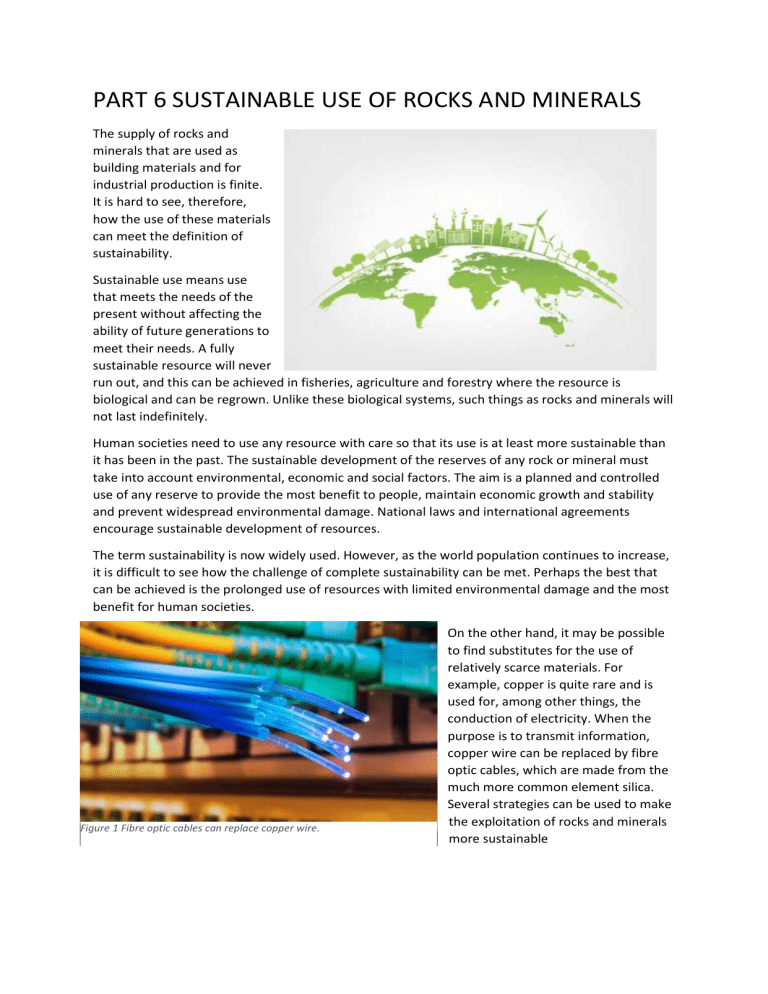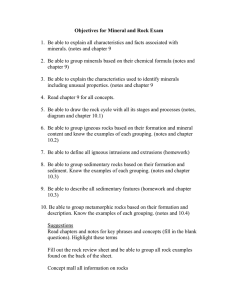
PART 6 SUSTAINABLE USE OF ROCKS AND MINERALS
The supply of rocks and minerals that are used as building materials and for industrial production is finite.
It is hard to see, therefore, how the use of these materials can meet the definition of sustainability.
Sustainable use means use that meets the needs of the present without affecting the ability of future generations to meet their needs. A fully sustainable resource will never run out, and this can be achieved in fisheries, agriculture and forestry where the resource is biological and can be regrown. Unlike these biological systems, such things as rocks and minerals will not last indefinitely.
Human societies need to use any resource with care so that its use is at least more sustainable than it has been in the past. The sustainable development of the reserves of any rock or mineral must take into account environmental, economic and social factors. The aim is a planned and controlled use of any reserve to provide the most benefit to people, maintain economic growth and stability and prevent widespread environmental damage. National laws and international agreements encourage sustainable development of resources.
The term sustainability is now widely used. However, as the world population continues to increase, it is difficult to see how the challenge of complete sustainability can be met. Perhaps the best that can be achieved is the prolonged use of resources with limited environmental damage and the most benefit for human societies.
Figure 1 Fibre optic cables can replace copper wire.
On the other hand, it may be possible to find substitutes for the use of relatively scarce materials. For example, copper is quite rare and is used for, among other things, the conduction of electricity. When the purpose is to transmit information, copper wire can be replaced by fibre optic cables, which are made from the much more common element silica.
Several strategies can be used to make the exploitation of rocks and minerals more sustainable
Efficiency of extraction
Increasing the efficiency of extraction seems an obvious starting point. For example, underground coalmines only remove between 55 and 70% of the coal present in the reserve.
This is because of the technical difficulties of extracting the remaining coal in a safe and costeffective manner. Open-pit mining is more efficient at extraction than underground mining, but some
Figure 2 Bigger and more efficient mining equipment cuts down on costs wastage still occurs. To improve the efficiency of extraction, many mine wastes are now being processed for a second time. This allows valuable materials to be recovered and reduces the risk of pollution from stored mine waste.
New extraction methods include chemical treatment of the waste, which extracts much of the valuable mineral still within it. Biological treatment with microorganisms can also be used to extract more product from the waste.
Improvements in the performance of the machines used in mining and processing also increase the efficiency of extraction. Greater use of data analysis by computers is likely to lead to improvements as well.
However, surface mining has more potential for an increase in efficiency of extraction than underground mining. This is because it is more difficult to predict geological conditions underground.
Efficiency of use and recycling
Recycling materials makes an important contribution to the sustainable use of rocks and minerals. Many manufactured goods, from cars to steel cans, are recycled in most countries. Most metals can be recovered and refined back to clean metals to be used by industries again. This uses less energy than processing the ores or concentrates to make metals. Many countries still have the potential to recycle far more materials in the future
Figure 3 Large car scrap yards are now being recycled to save on energy production
Attempts to use minerals such as metals more efficiently include engineering solutions. For example, it is possible to design steel beams used in buildings to have the same strength but use less steel. In the 1980s titanium became very expensive and there was an incentive to design products that used less of this metal. Many countries may in the future require car manufacturers by law to take back their products when they are finished with. It is hoped this will encourage them to make more durable products that use less minerals and last longer.
S
SELF ASSESSMENT QUESTIONS
-A
SSESSMENT QUESTIONS
1) Suggest one advantage of in situ waste treatment and one advantage of ex situ waste treatment.
2) Describe three ways in which recycling materials is important for the sustainable use of resources.
Summary
After completing this chapter, you should know:
the characteristics of named igneous, sedimentary and metamorphic rocks
how these rocks are formed in the rock cycle
the features of surface and subsurface mining
how we decide to extract rocks and minerals
the environmental, economic and social impacts of rock and mineral extraction
how landscapes damaged by rock and mineral extraction can be restored and how successful these strategies can be
the meaning of sustainable resource and sustainable development
how rocks and minerals can be used sustainably.



